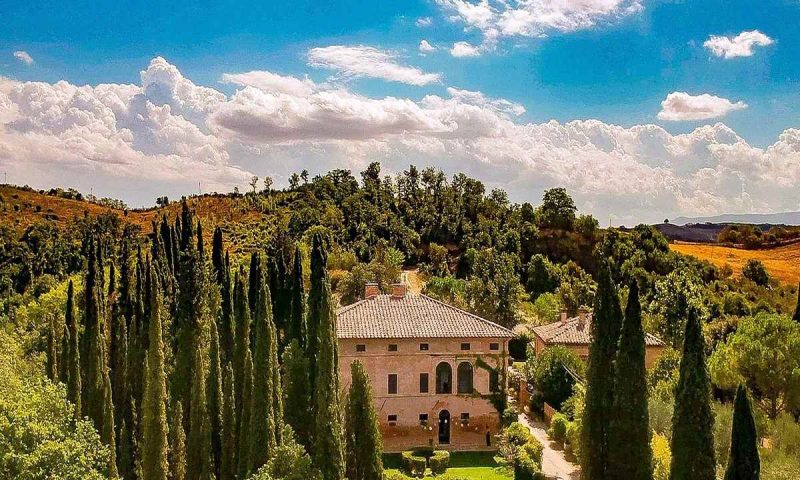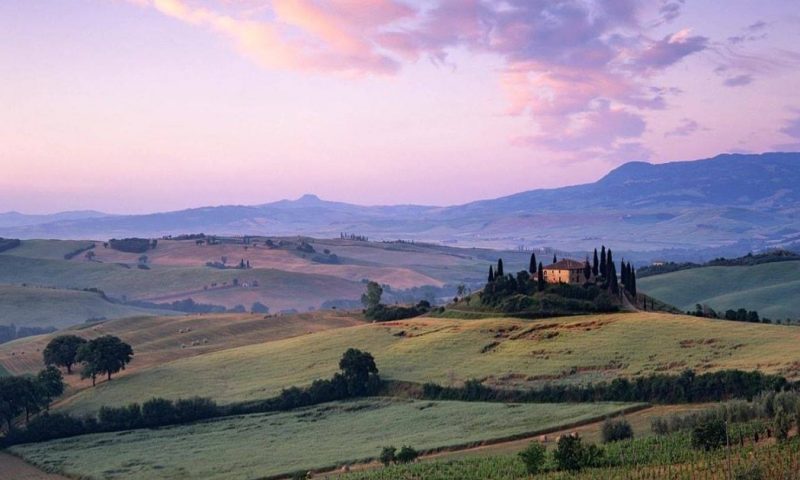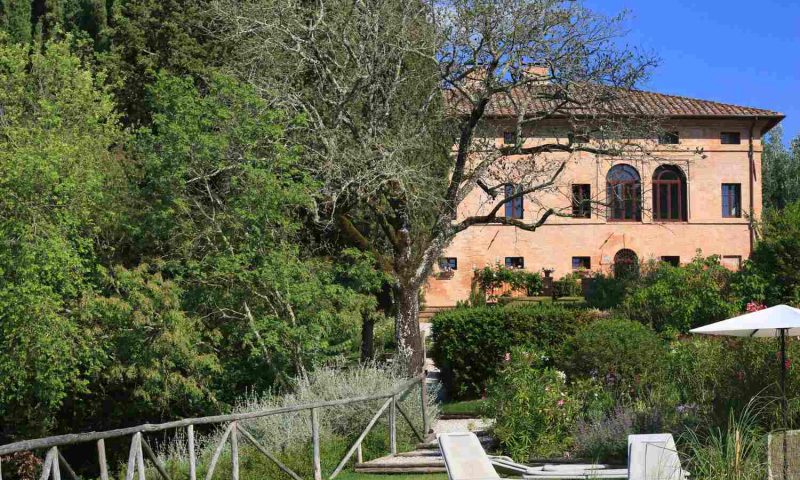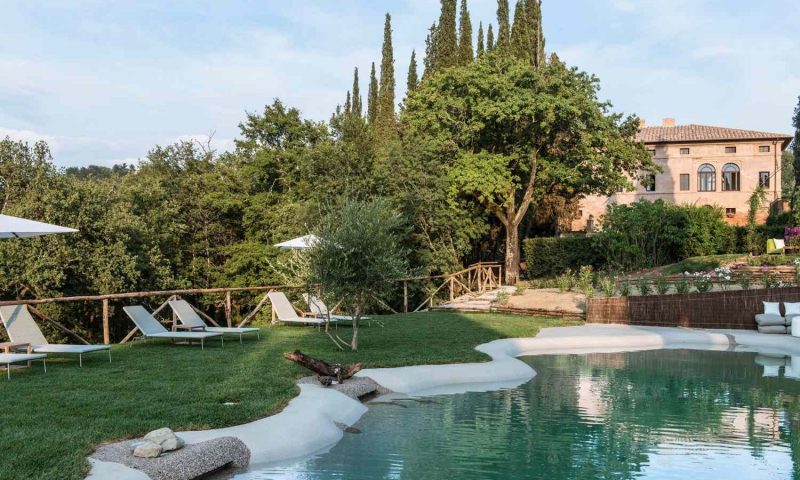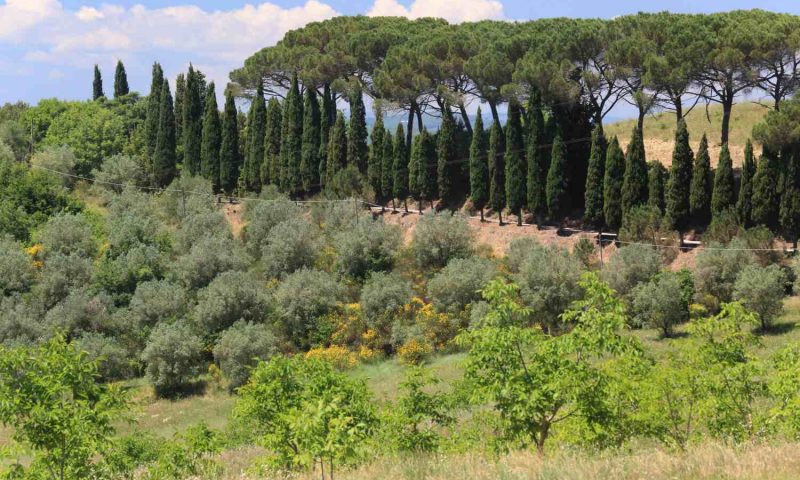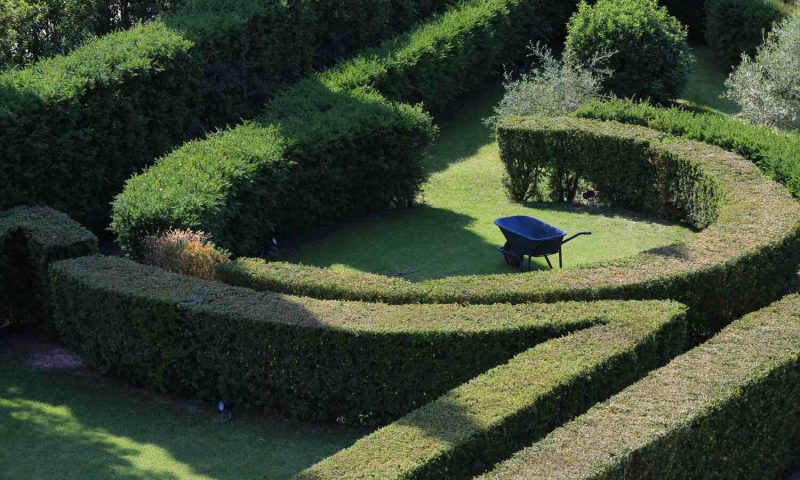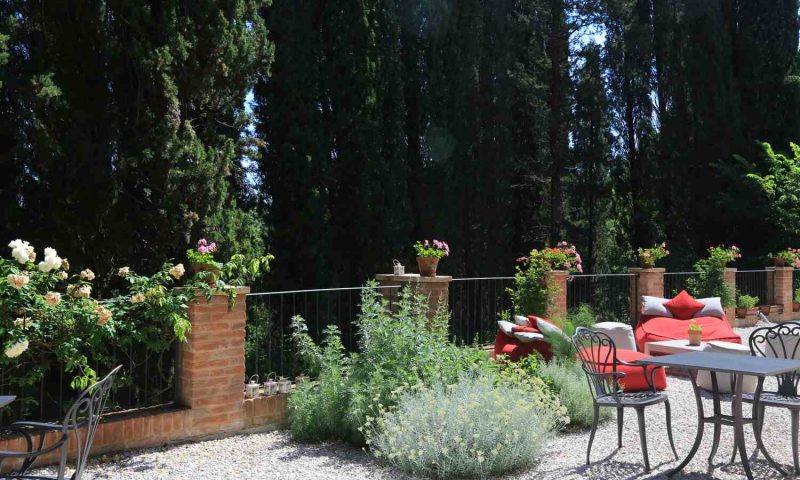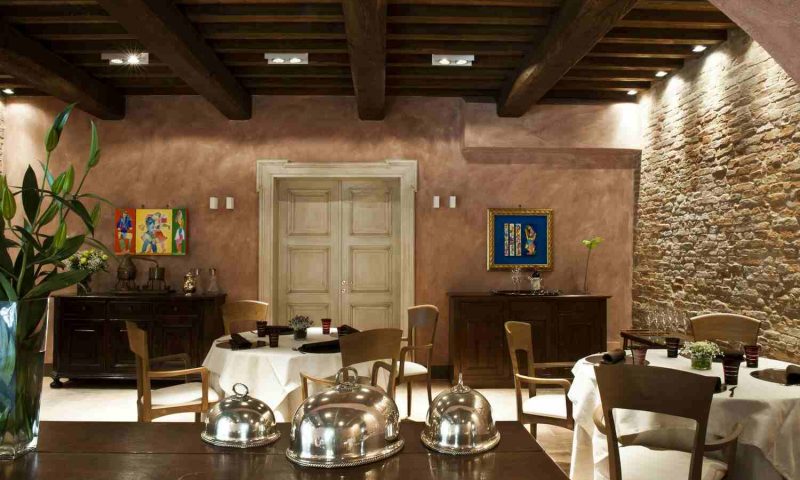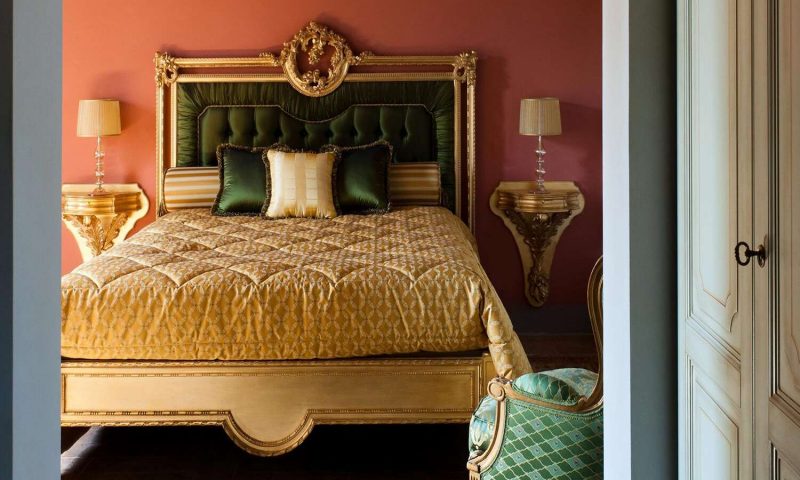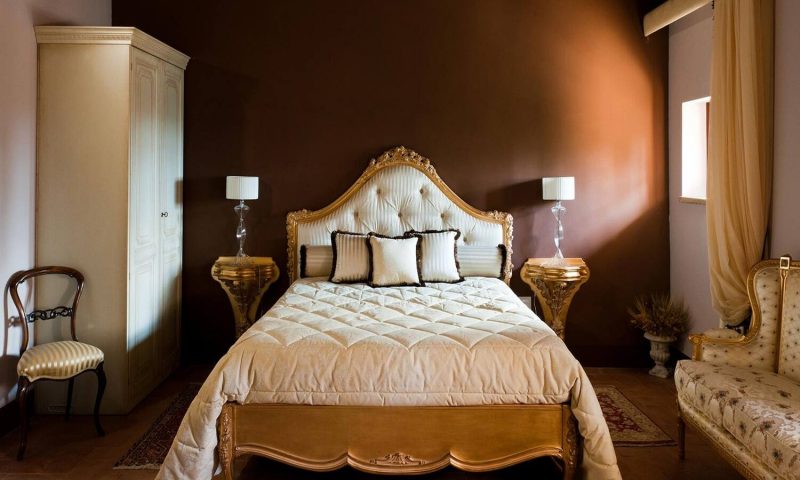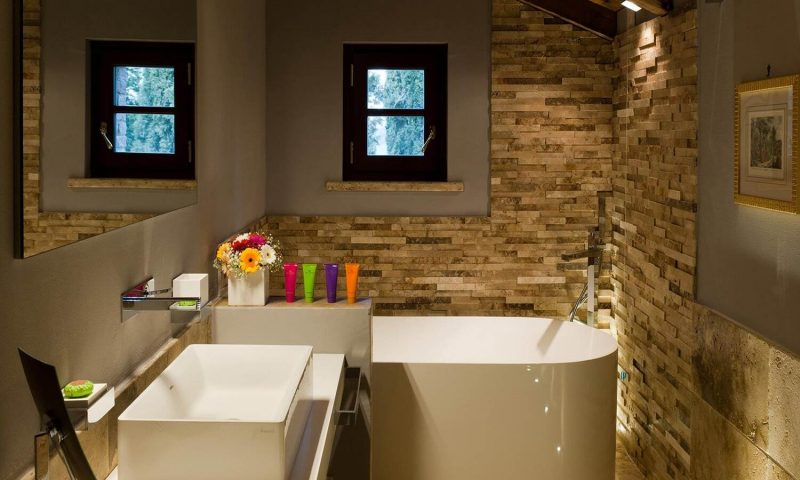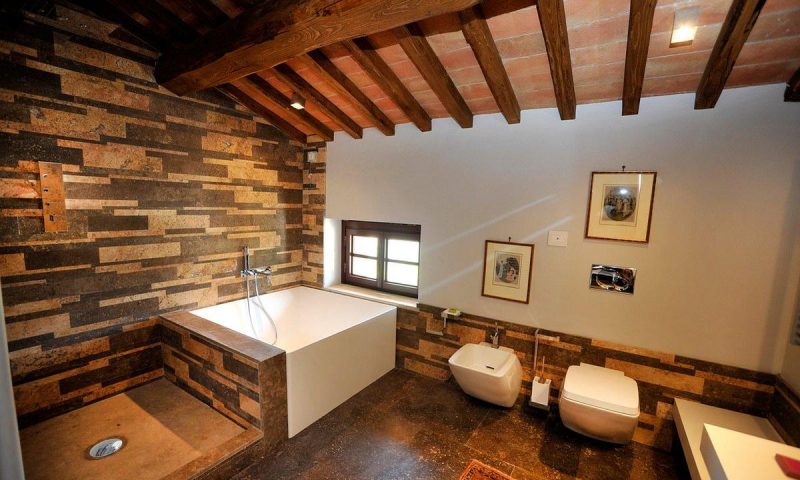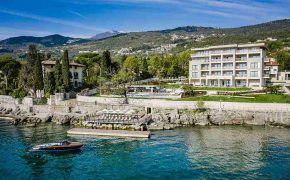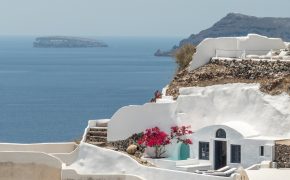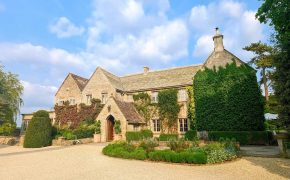Located in the romantic heart of Tuscany, only 20 minutes from Siena, only a stone’s throw from Montalcino and Val d’Orcia, in a fairytale world exuding magic and beauty, Villa Armena is a late Renaissance structure.
Built of red brick, with original oak beams and roof, and having terracotta floors and a beautiful Italianate garden, Villa Armena today is an exclusive establishment with just 10 rooms, each one unique, where service, attention to detail and exclusivity are the cornerstones of our offering.
Close your eyes for a moment and imagine walking on a carpet of soft grass between rows of cypress, maritime pines and olive trees. The air is fresh, the sky a perfect shade of blue, and the sun gently caresses your skin with its warmth. All around you … a many-coloured multitude of roses … Welcome to Villa Armena! A magical place where your senses will come alive.
THE HISTORY
The Villa, whose construction is attributed to Baldassarre Peruzzi, was built in the first half of the sixteenth century. It was the country residence of the noble Malavolti family from Siena who had the good fortune to number among their ranks nine Captains of the People, in other words the most important figures in Siena’s political landscape at that time.
Legend has it that the name Armena was given to the Villa and its immediate surroundings by a member of the Malavolti family who, returning from the Crusades in the Holy Land, stopped off in Armenia and fell in love with a beautiful local girl.
He returned to Italy to get married and decided to devote his feud to his betrothed, calling it Armena as a sign of respect for the origins of the one who had entered his heart and his life so forcefully.
HIDDEN CHARM
Once upon a time there was a dream. Joy, nature and family. There was once a villa. Left to its own devices, marked by the passage of time and neglected, yet still incredibly bewitching. Hidden from sight but not from the heart.
Today that dream has become reality; the Villa has recovered its former splendour and allure. Irrepressible, it has witnessed a triumph of history, magic and pure beauty… Ladies and Gentlemen, welcome to Villa Armena, your personal Renaissance villa in the heart of the Crete Senesi area!
WHERE THE SUN IS STILL WARM
Villa Armena, Buonconvento, is in the heart of the Crete Senesi. An astoundingly attractive area of unsurpassable historical interest, Buonconvento – whose name derives from the Latin “bonus conventus” meaning a good-natured, fortunate community – is a member of the prestigious “Most Beautiful Villages in Italy” Association.
Imagine age-old villas, country houses, monasteries and abbeys. Imagine endless rows of vineyards that seem to chase each other over the hills. Imagine small groups of olive trees, so close to each other that they seemingly protect and caress each other with their long branches.
Imagine hundreds of cypress trees competing to reach that small cloud floating in the sea of blue above them. Imagine all that and, after a glass of Brunello, a local farmer’s greeting, and the innocent smile of a local child, you’ll fall hopelessly in love with this small, humble part of the world where the sun remains warm and the air fresh and delicate.
ROOMS & SUITES
Villa Armena offers a total of 10 rooms, all very different from one another. There are four categories: three Classic rooms, one Junior Suite, five Suites and a Superior Suite. Each room enjoys stunning views over the Villa grounds or the wonderful Crete Senesi and comes with precious furnishings, prints, paintings and fabrics.
With a wealth of history, yet boasting all modern amenities, the Villa Armena rooms were designed and built to provide the utmost satisfaction for our guests. Plan a stay at our Toscana boutique hotel today.
DINING
Our “Made in Italy” approach leads us to support local Kilometre 0 products and, where possible, to use “Slow Food” produce which is a byword for exceedingly high quality and certified origin.
THE SORBO ALLEGRO
This hundred-year old tree that welcomes guests to the Villa garden gave its name to our restaurant. So why do we use the word Merry?
Because dining in company is a crucial moment of the day, one which must be lived in a superbly maintained, elegant atmosphere exuding a sense of pleasure; where tradition meets imagination to produce results which are excellent and never dull. The same care and attention is paid to breakfast, taken in the conservatory, where the warm Tuscan sun will be the first to greet you in the morning.
RELAXATION AS A LIFESTYLE
As in any self-respecting house Villa Armena has its own living room. A special room where you can relax after a long day exploring Tuscany, challenging yourself on the greens at one of the affiliated golf-clubs or just lounging in the sun by the pool. In fact Villa Armena is not a hotel, but a Tuscan Villa belonging to the Hosts and this room perfectly encapsulates their philosophy.
Here you will find a selection of fine “vini da meditazione” in other words, wines to be enjoyed on their own, unaccompanied by food, a wide selection of different types of grappa and the best liquors from all over the world. Enjoy a drink whilst lounging in an armchair, gazing over the beautiful Tuscan countryside. Guaranteed to stir the heart.
A STROLL AMONG ITALIAN WINES
Ours has been and continues to be a painstaking pursuit of excellence in the world of Italian wine. We eschew typical mass-produced classics and instead focus on lesser-known, smaller vineyards, where you will find passion and professionalism and where the products are genuine.
Our wine cellar will give you an overview of Italy’s regions, from Valle d’Aosta to Calabria, taking in the islands too. In search of age-old genuineness that speaks of history and tradition. Italy: truly wonderful!
WEDDINGS IN TUSCANY
For most people Tuscany represents the best of Italy: stunning scenery, art, history, culture and top-class cuisine. Villa Armena is the ideal location for successful events not only on account of the romantic atmosphere it exudes but also due to its excellent geographical position (at the heart of Italy and linked to five international airports), its impeccable, sophisticated service and the helpfulness of its staff.
HISTORY, CULTURE AND LANDSCAPES
The Siena landscape is made of colour: so many different shades. Taste: unique products, a gift from a bountiful mother earth. Perfumes: strong, centuries-old, captivating. A land of poets, painters and sculptors encompassing an extraordinary historical, artistic, cultural and environmental heritage.
Tradition, history and a food and drink cornucopia within a truly unique landscape and a multi-faceted, protected natural environment. Here man and nature still live in harmony and mutual respect. Here time has stood still for the last couple of centuries.
IN THE HEART OF TUSCANY
Villa Armena is fortunate to be in the beating heart of the province of Siena, in a part of Tuscany known and loved all over the world. The most romantic Tuscany, the Tuscany of gentle hills, churches, dazzling landscapes, medieval monasteries and priceless works of art. A veritable triumph of beauty. We are proud of our district and at the same time glad to share it with our guests, because certain emotions are impossible to explain.
They can only be lived. And so we have prepared this little guide which we hope will be of assistance to readers, helping them to get their bearings in this humble yet marvellous corner of Italy, spending a fantastic day in the company of the hot Tuscan sun. When the sun goes down, you will return to Villa Armena and revel in the memory of the day coming to a close, sipping a glass of Brunello together with your loved ones.
THE CRETE SENESI
A journey through the Crete Senesi is like an eyes-wide-open, feet-on-the-ground dream because the Crete are “anatomically” the impalpable soul of a seductive body which sometimes expresses itself in the sculpted form of a Greek statue and sometimes with the sinuous curves of a siren.
The Crete Senesi then, as a journey of the soul, a journey of discovery to be embarked on with the same spirit as those who went on the Grand Tour, without seeking out mystical, pointless destinations. Meandering through the earthen waves of the Crete each one of us can find places that “speak” with the breath of the wind and with the magic of unpredictable light.
There are no iconic destinations such as squares, cathedrals or castles to identify this territory, just intimate spots such as that cypress tree over there, an old farm, the curve of that road, the farm window, or moments linked to strong feelings like the smell of pecorino cheese which permeates the shelves of a small grocery store, the soothing warmth of hot springs, the mystical simplicity of a small Romanesque church.
The landscape of the Crete is the harmonious triumph of the essential over the frivolous, a timeless image, a picture that blends the forms of an Etruscan graffito with modern art. Harmony that takes hold of you and has the power to balance energy levels: emotions and sensations change shape, calmly contracting and expanding.
MONTALCINO
For those travelling up from the valley floor, the imposing fourteenth century fortress immediately reveals the layout of Montalcino, a medieval town with a defensive military structure, furrowed by steep, narrow streets.
From up here, the landscapes are veritable works of art just like those kept in the Museo Civico Diocesano d’Arte Sacra, which houses one of the most precious collections of Sienese painting and wood sculpture. Among the many churches the S.Agostino, the neoclassical cathedral, the Sanctuary of the Madonna del Soccorso and S. Egidio, the “de senesi” church stand out.
The Town Hall (late thirteenth century), a slender but robust structure flanked by a high steeple, almost a watchtower topped off by the “Big Bell” that still marks time for the townspeople.
9km from the center of Montalcino heading towards Castelnuovo dell’Abate arises the solitary Abbey of S. Antimo, whose monumental temple (twelfth century) is one of the finest examples of the Romanesque-French style in Italy.
The Montalcino district, so inviting for lovers of hiking and culinary pleasures, and featuring thick forests interspersed with traditional vineyards and olive trees, opens up where sight and thought are inevitably lost in the Val d’Orcia landscape. As proof of this, the Montalcino territory, with the Val d’Orcia, was awarded World Heritage Site status in 2004.
In a strategic position between the Maremme area and valleys of the interior, with its churches, palaces and fortifications and works of art, it has also marked many crucial moments in the story of medieval and modern Tuscany alike.
And even the “Poggio della Civitella” with an Etruscan settlement dating back to the fourth century BC, confirms the importance of both the site and those who once trod its soil. Established within the domain of the extremely powerful Abbey of St. Antimo the “castle” of Montalcino was soon fought over by the counts of Siena and Florence.
Under Pius II it became a Diocese and then a Town in 1462. Later, an impregnable Siena fortress, it yielded only to the Treaty of Cateau-Cambresis under which Siena was annexed to the Medici Grand Duchy (1559).
Lastly, the famous “Festival of the Thrush” deserves a mention; it takes place on the last Sunday of October and allows guests to experience local culture through the re-enactment of ancient traditions.
PIENZA
Pienza is situated in the beautiful Val d’Orcia and is known as the city of Pope Pius II, born Enea Silvio Piccolomini, in 1405. Pius II wished to create a worthy town which was unlike the town which had ostracised him, together with his family: Siena.
He demanded that famous architects and artists work on the project in accordance with the building and philosophical standards of an era that was full of promise: the Italian Renaissance. Pienza was built in just three years, from 1459 to 1462; it was the Perfect Town, the Utopian Town.
A town whose midwife was “love and a dream of beauty” as Giovanni Pascoli wrote. The town as well as the entire surrounding Val d’Orcia has been recognized by UNESCO as a World Heritage Site.
Lastly, the beautiful village of Montichiello is worthy of mention; the locals still keep alive the ancient tradition of the Poor Theatre, demonstrating the town’s vitality and the townspeople’s ability to gather together and put on a show to celebrate their own history and identify.
CORTONA
The Town of Cortona is in the province of Arezzo, on the slopes of a mountain between Valdichiana and the Tiber valley; it used to be an important Etruscan town. All that remains of the Etruscan period are important ruins of the town walls possibly dating back to the fifth century before Christ and which extend for around 2 km.
The old town centre as we know it today was formed in the thirteenth century: in 1241 the Town Hall had already been built; in 1245 the church of San Francis was built and in 1250 the Palazzo del Popolo.
In 1456 works commenced to repair the new Cathedral where the old Santa Maria church one stood, whilst in 1480 the Siena architect, Francesco di Giorgio Martini, embarked on the construction outside the town of the Madonna delle Grazie Sanctuary at Calcinaio.
The town has a wealth of museums and works of art from the Museum of the Etruscan Academy to the Diocesan Museum including treasures such as the Annunciation of Fra Angelico, Madonna in Glory by Bartolomeo della Gatta and the Deposition by Luca Signorelli. Do not miss the archaeological park, the Medici Fortress of Girifalco and the Abbey of Farneta.
MONTEPULCIANO
Montepulciano lies at the junction of two valleys, the Val d’Orcia and Val di Chiana. Built along the narrow summit of a limestone hill, this beautiful medieval village seems to be the natural continuation of the hill on which it is built.
Coming by car from the charming but somewhat more touristy, “utopian” town of Pienza, just eleven kilometres away, the landscape just before reaching the village represents everyone’s archetypical idea of classic Tuscany, waves of rolling green hills and cultivated fields.
Immediately below the town walls and fortifications, visitors can admire the beautiful church of Madonna di San Biagio. The white pearl Travertine with which the building was erected in the early sixteenth century stands out in the distance against the surrounding fields, welcoming all those deciding to spend a day strolling through the village streets.
Leaving the car in one of several car parks outside the walls visitors can walk along the banks of the river that flows through the stylish old town centre which winds its way up the hill along the imposing Renaissance palaces, until it reaches the central square.
Piazza Grande, situated at the highest point of the village is dominated by the large tower and the gothic façade of the Palazzo Comunale. Opposite the town hall visitors can admire the Cathedral which dates back to the late sixteenth century.
Despite its undeniable beauty, Montepulciano is internationally known above all for its Vino Nobile, one of the most popular Tuscan wines, one which is obtained by pressing grapes from vineyards around the borgo.
AREZZO
The town of Arezzo is extremely ancient, older even than Alexandria. It was one of the major Etruscan Lucumonies and later a Roman city of strategic importance. It was a flourishing business hub with a wealth of precious monuments among which we should mention the amphitheatre of which much remains.
Medieval Arezzo was a free city where the interests of the Ghibellines, rivals of nearby Florence, often prevailed. Few other areas in Italy can boast such a rich natural and cultural heritage in such a compact area. Frescoes by Piero della Francesca in the Duomo [cathedral] alone are worth a visit to the town.
But even the medieval heart of the old town speaks volumes about Arezzo’s epic seasons of art and architecture. Alongside its medieval towers, stands the imposing Vasari Loggia [porch], the Palace of the Fraternity of Laymen, a fine blend of gothic and renaissance architecture and the apse of the Church of Santa Maria.
The cross painted by Cimabue, an early work by the artist, is preserved in the Basilica of San Domenico. With their haunting beauty and their stylistic originality, many other churches and palaces bear witness to Arezzo’s civilization and its importance throughout great historical periods.
On the second Saturday of June and the first Sunday in September, Piazza Grande becomes the setting for the Giostra del Saracino, a jousting tournament whose origins date back to medieval times. Every first Sunday of the month and the previous Saturday, this square and much of the old town centre play host to the Antique Fair.
Arezzo’s Antique stall owners have the art of haggling over prices down to a tee. We can only adapt. The Chianina cattle farms are also unmissable; the animals are enormous with a typical white/black coat and can be seen throughout the countryside around the town.
MONTERIGGIONI
The municipality of Monteriggioni retains many vestiges from the past, bearing witness to the fact that it has been inhabited at least since the eighth century BC, as evidenced by the settlement discovered at Campassini as well as the extensive Casone Etruscan necropolis.
The main draws are represented by the castle of Monteriggioni and by the nearby Abbadia Isola, but the whole area is dotted with castles, churches, villas and small villages, surrounded by beautiful unspoilt countryside. Monteriggioni perches on the top of a gentle hill whose slopes are planted with vines and olive trees.
The castle was founded in the second decade of the thirteenth century by the Republic of Siena, with the main aim of creating a defensive outpost against its chief rival, Florence. Its military function dwindled after the mid-sixteenth century, when the entire state of Siena was annexed to the Florentine state.
Monteriggioni still retains most of the structures of the thirteenth century and is absolutely unique in the panorama of medieval Tuscan villages and towns. Its town walls, which are roundish in shape, encompass the top of the hill and run for approximately 570 meters; the town also boasts fourteen massive towers protruding from the outer surface of the walls.
The small town inside the walls was built around a large rectangular square, overlooked by the church of S. Maria Assunta. This is definitely the medieval building which is best preserved, though the entire village, with its characterful narrow streets, boasts many houses which clearly date back to medieval times.
SIENA
Siena is quality of life writ large and the first European town to close its centre to traffic way back in 1966. Siena, a place of international culture, whose University is a sprightly 750 years “young” and which is home to prestigious institutions such as the Accademia Chigiana, the University for Foreigners, the Accademia dei Fisiocritici and the Accademia degli Intronati.
This is the town where not even a stone has been moved over the centuries and which exudes an atmosphere that can be found nowhere else because its people have kept alive the traditions of their fathers, such as those regarding the celebration of the Palio, renewing them each year with undiminished strength and vigour.
Siena, a settlement of Etruscan origin, was a Roman colony with the name of Sena Julia; it was most important during the Middle Ages, being defeated later by the Lombards and then passing under the Carolingian domination.
After a long period of Episcopal dominion (9th-11th century) the town reached its peak after becoming an independent municipality (1147), adopting a policy of expansion at the expense of the neighbouring territories.
Confrontation with Florence was inevitable and the struggle lasted, with various ups and downs, until 1555, when after a long siege, Siena was conquered by the Florentines, losing its independence and becoming part of the Grand-duchy of Tuscany, sharing its fortunes until the Unification of Italy (1861).
COLLE VAL D’ELSA
The old part of Colle di Val d’Elsa is perched on a high hill and the narrow valleys that surround it previously divided the urban fabric into three sections: the “Plain”, “The Old Centre” and “the Castle” today simplified as Uptown and Downtown. There is a custom in the Val d’Elsa of getting things done.
The town also gave the river a leading role to play in the history of the area. The glass industry was first established here at the end of the sixteenth century, a harbinger of the cut glass business for which Colle is world-renowned.
But for us modern visitors the town offers countless attractions from the works of art collected in the Town Art Museum and religious art, housed in the Palazzo dei Priori which is itself a work of art, to historical treasures kept in the exceptional collection of the Ranuccio Bianchi Bandinelli Museum.
This collection boasts unique pieces such as those in the Terrosi collection, such as the very rare “kelebai” from Volterra. But we can not leave Colle route without first walking the streets of the Town which even today bears witness to medieval industrialization, without admiring the cathedral, without paying homage to the tower house at the end of Via del Castello, where tradition has it that Arnolfo di Cambio was born.
The former Conservatory of San Pietro, designed by Vasari, the younger, is undoubtedly a treasure-trove of art and architecture and it is intended to house all the town’s museums.
But Colle’s architectural gems do not end here: from Palazzo Campana, which effectively closes off the top of “the Castle” to the Teatro dei Varii, from the Convent of San Francesco in Via delle Volte, a hundred yards stroll that paints a medieval picture of the Castle.
There are countless works of art which are kept in Arnolfo’s town: starting with those by Cennino Cennini another town glory, a sublime painter who lived between the fourteenth and fifteenth centuries. In short, a jewel of a town where art meets history, thereby creating a lifestyle which for modern visitors also involves fine opportunities for shopping.
SAN GIMIGNANO
San Gimignano, a UNESCO World Heritage Site, owes this award to its towers. Once there were 72 but now only thirteen; they give character to the elegant town in the province of Siena. Its worldwide fame is due not only to its particular architecture, but especially to the wealth of art and to Vernaccia di San Gimignano a fine white wine which is only produced here.
It seems that the variety had been introduced for the first time in the town of San Gimignano by a certain Vieri de’ Bardi, from Liguria, around the thirteenth century. It was later his descendants, Zanobi and Angiolo Bardi, who first started growing the grape variety that was to become very popular and famous.
Back in1276 there was a flourishing trade in Vernaccia di San Gimignano so much so that, in the “Ordinamenti della Gabella” issued by the Town of San Gimignano that year, of “three coin” tax was introduced for every mule-borne load of Vernaccia outside the Town.
Not to be missed is the Duomo; completed in 1148, it is considered one of the most prestigious museums in Tuscany. Built on three naves it has frescoes by the Florentine School painters: St. Sebastian (Benozzo Gozzoli), Stories of Santa Fina by Domenico Ghirlandaio and Wooden Statues by Jacopo della Quercia.
Also of interest is the Town Hall, which formerly housed the mayor’s office. It currently houses the civic museum and the art gallery containing masterpieces by artists such as: Pinturicchio, Benozzo Gozzoli, Filippino Lippi, Domenico di Michelino, Pier Francesco Fiorentino.
Also inside the Town Hall you can visit Dante’s hall with the Majesty by Lippo Memmi and you can access the Torre del Podestà, or Big Tower, 54m high and dating back to 1311.
COOKING CLASSES
Tuscan tradition is inextricably linked to its flavours, aromas and cuisine. We are therefore delighted to offer our guests the fantastic opportunity to take part in cooking lessons during which the instructor will reveal the tricks and secrets behind preparation of the most famous Tuscan dishes.
And after the “lesson” everybody will dine together on what has been cooked, washed down with plenty of top-notch Tuscan wine. A truly unique experience and not to be missed!
BOUTIQUE HOTEL INSIDE THE WALLS
Siena is famous throughout the world for its Contrade. There are 17 in all. This mini tour will allow you to become familiar with the origin, history and rituals.
You will visit some museums: real gems which preserve with religious care not only relics related to jockeys and horses from previous races but also the actual flag fought for and won in Piazza del Campo in the legendary Palio. And if you’re lucky enough to take part in this most original mini-tour on July 1 and August 16 you will also attend the rehearsals for the race!
Every person who lives in Siena strongly identifies with the values and traditions of their own Contrada; if you understand the dynamics it will help you to better understand both Siena’s past and present.
THE “FINE ARTS” WALK
Do you love art? Do you love beautiful art? This beautiful mini-tour will allow you to discover some of Siena’s most precious treasures. Amazing works such as the Fonte Gaia, the facade and the pulpit of the Duomo [Cathedral], the majesty of Duccio di Buoninsegna or the “Good and Bad Government” by Lorenzetti are some of the masterpieces that you will see and learn about.
BRUNELLO DI MONTALCINO, THE KING OF WINES
Montalcino, home of Brunello, the king of Italian wines, is a small town perched on a hill south of Siena. The first leg of the tour will be to a vineyard belonging to one of the most important producers of Brunello in the entire region.
Here, after a delightful walk through the vineyards where the secrets to a perfect wine will be revealed to you, you can visit the winery and taste this divine nectar that we mortals call Brunello.
Sated, we will head for the spectacular Sant’Antimo abbey, the most important example of Romanesque architecture in the whole of Tuscany, dating back to the twelfth century. This will be followed by a typical Tuscan lunch.
But it will not be an ordinary meal: you will eat at an old mill still used to press oil where you will learn the secret to producing sublime extra virgin olive oil. We will then head for Montalcino where you can admire the beautiful medieval fortress, and afterwards you will be able to stroll the streets in the town centre, calling in at wine shops or whatever takes your fancy.
And to round off a perfect day how about another visit to a vineyard where Brunello is produced? You’ll find it very hard to say no to an offer like this. Duration of tour: Around eight hours
CLASSIC CHIANTI, GALLO NERO
This trip focuses on the beating heart of the Classic Chianti area, the area that begins just south of Florence and ends just before Siena. Between tasting sessions, you will find time to discover the surrounding area and learn how this great Italian wine is produced.
The first stage will be in an old medieval town perched right on top of a hill: Castellina in Chianti. Here you’ll appreciate how this wine has shaped and transformed the region’s destiny and you will also be able to visit some shops owned by true craftsman who still closely follow Tuscan tradition.
You’ll also have the opportunity to taste the fantastic olive oil and amazing vinegar produced in these beautiful areas. And then off to the first vineyard. You will visit the magnificent winery where you will be told not only how Chianti is produced but also about other typical local produce.
You will taste the wines produced here and which will probably include at least one Classic Chianti, a Riserva and an IGT Super Tuscan. After all this wine a meal is in order so you will stop for lunch at a typical local trattoria or at another farm.
After lunch, to aid digestion …. you will visit another agricultural estate! So you will round off your day dedicated to one of the most famous wines in the world before returning to Villa Armena to wind down after such an exciting day out. Duration of the tour: Around eight hours
VINO NOBILE DI MONTEPULCIANO
The historic towns of Montalcino and Montepulciano are often confused with each other because the names are so similar. But whilst Montalcino has Brunello, Muntepulciano is famous for its “Vino Nobile”. This is also where the very best Vin Santo in the whole of Tuscany is produced.
The day kicks off with a visit to a vineyard where Vino Nobile di Montepulciano is produced in order to see their historic wine-cellar. You will taste their wines in the beautiful garden offering wonderful panoramic views over the beautiful Tuscan hills. You will also be provided with a small snack.
Afterwards you will make your way to a second producer for a second round of tasting. This will be followed by a delicious lunch at a small trattoria where you will be served typical Tuscan specialties.
After all this eating and drinking maybe it would be a good idea to go for a walk and in fact you will visit the town of Montepulciano; you can choose between studying the town’s history in greater detail or visiting a third (why not?) wine producer after which you return to Villa Armena; it will be our pleasure to ensure that your evening is totally relaxing. Duration of tour: Around 8 hours
VERNACCIA DI SAN GIMIGNANO
San Gimignano is a small town south of Florence which is famous for its tall medieval towers. But it is also the town where one of the most important white wines of Italy, Vernaccia di San Gimignano, first saw the light. The very first white wine ever to receive the DOC [registered designation of origin] designation in 1966.
This is a truly lovely part of Tuscany, with its gentle hills and strong colors. The first leg of the tour will be to a famous chocolate maker in the area where you will savour his delicious handcrafted chocolate. Truly a product from earlier times. Afterwards you will travel to the first winery.
An organic / biodynamic producer where the owner will accompany you on the tour to explain all the tricks of the trade. Explanations which will be followed by the first tasting session of the day. You will then travel to San Gimignano for a quick visit to this wonderful town which has been recognized by UNESCO as a world heritage site.
You can buy many different local products here. Lunch will be taken either at an amazing farm which produces saffron or at a wonderful local trattoria.
This will be followed by another visit to a winery where you will be served the classic Vernaccia di San Gimignano, the Riserva and several reds including a Super Tuscan. And then, everybody back to Villa Armena where you will have the opportunity to relax after such a busy, interesting day. Duration of tour: approximately 8 hours
HALF DAY IN CHIANTI
A relaxing bike-ride in the Sienese countryside, combining good food, wine and fun for all, beginners and families alike. From Villa Armena you will be taken to a spectacular XIV century monastery, the Certosa di Pontignano in the heart of Classic Chianti; this is where the trip begins.
You will cycle along quiet country roads, far from traffic at the speed that most suits you, among vineyards, olive trees and cypresses. You will stop off at the beautiful medieval village of Vagliagli to enjoy a light lunch of ham, fennel, cheese, olive oil and Chianti. After the meal you will be back in the saddle to continue the tour, mostly on downhill roads or on the flat, always travelling through a truly stunning landscape.
LE CRETE AND PIENZA
The tour kicks off from the famous Crete Senesi, specifically from Buonconvento, the home of Villa Armena, one of the 100 most beautiful villages in Italy, with a stroll through this wonderful town, before continuing with a visit to the Abbey of Monte Oliveto Maggiore, dating back to early 1300.
En route you will stop several times to photograph the fantastic Crete Senesi landscape, the most romantic area of Tuscany. San Giovanni d’Asso is a small village perched gently on a hilltop, famous for its truffles: how about a lunch of truffles in a typical local trattoria?
But if you enjoy Pecorino cheese with truffles then maybe you’ll enjoy lunch at one of the many farms in the Crete which produce the best Pecorino in the whole of Tuscany! The tour continues towards Pienza, in the heart of Val d’Orcia, a Renaissance town, created by Pope Pius II.
In this quaint village you’ll find many small local crafts shops where you can buy all manner of local products. And after a coffee and a stroll through the streets of this charming village you will return to Villa Armena for an evening of relaxation.
ABBEYS OF TUSCANY
This tour takes you to three of the most famous abbeys in Tuscany. The first one, the Abbey of Monte Oliveto Maggiore dates back to 1319 and is decorated with 21 frescoes by Sodoma and Signorelli.
After visiting all the wonders that this beautiful monastery has to offer, you head for Sant’Antimo Abbey, dating back to the eleventh century, just in time to hear the splendid Gregorian chant of the chorus of monks.
Lunch will be at a restaurant in a small village overlooking Sant’Antimo or in Montalcino; it is up to you to decide. In the afternoon, you will go to the “ghost” Abbey of San Galgano which is famous for its Sword in the Stone. This is where the day ends and you will then return to Villa Armena where an evening of good food and relaxation awaits you.
TRUFFLES AND OLIVE OIL
This wonderful tour departs from the Crete Senesi, specifically from the Abbey of Monte Oliveto Maggiore. You can admire the 21 frescoes dating from the 16th century by Signorelli and Sodoma that adorn the beautiful cloister; you will learn all about the history of the monastery and you can visit the pharmacy of natural products managed by the monks.
From the monastery you will make your way to the “Romita” a family-run farm-house famous for the quality of its extra virgin olive. You will learn the tricks of the trade and have the opportunity to sample it. To wrap up this wonderful experience you will have lunch at a typical local trattoria, a very special lunch of pasta with truffles obviously accompanied by the best Tuscan wines.
